Shifting and moving back in a speed skating pack
With the Indoor Championships of speed skating in the horizon, Sila offers to perfect your moving technique within a speed skating pack...
Par alfathor
Everything for a successful indoor championship

 The aim of this card is to make you work on your shifting and moving back within a pack with specific drills and many tips.
The aim of this card is to make you work on your shifting and moving back within a pack with specific drills and many tips.
Aims
– Creating and taking pass opportunities
– Adjusting your trajectories choices to your position in the pack
– Increasing your alertness in the pack
– Perfecting your preparation for the PBM indoor French Championships
Passing techniques: The example of indoor
A track for the juniors, a mini-track for the grown-ups
Indoor is the playing field where skaters should be the most versatile in order to win races. Even if physical abilities remain important, other qualities are also essential. According to SILA Coaching, skaters able to win an indoor race of good level will have developed a panel of skills that will enable them to win a good number of outdoors races, both on track and road.
Mastering various passing techniques is an essential step in the accomplishment of a speed skater.
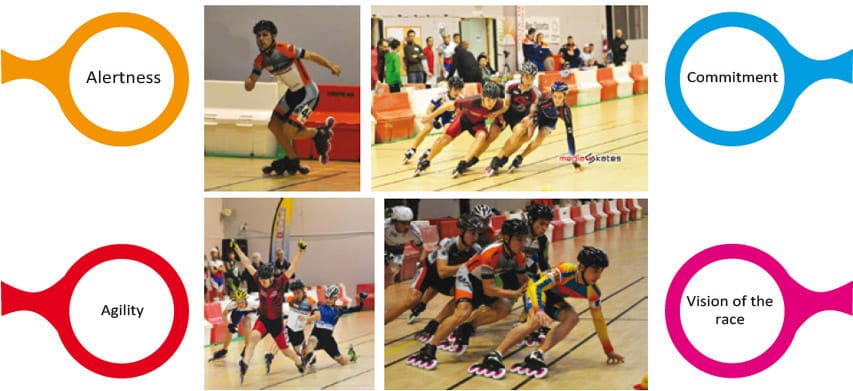
Different types of passing
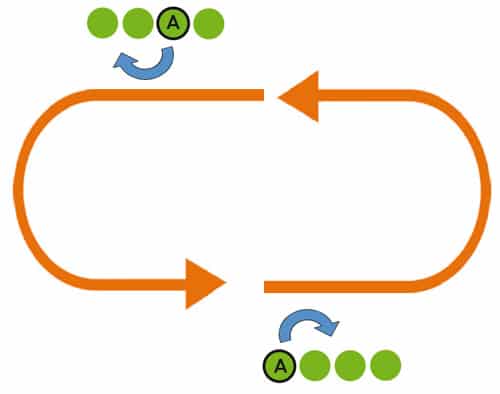
1) Inside Pass
The aim is to pass a skater without effort, on the inside, at the end of the straight line but before the corner! The timing is very important.
Make groups of 4 skaters, the last skater of the group has to pass the skater in front of him, on the inside, in the second half of the straight line, before the corner.
Our tips
- Always keep contact with the skater you are about to pass: with the hand then with the shoulder
- Make sure to have completed the pass before the corner entry
- Don’t hesitate to mark a ‘pass start’ area.
- For a successful action, the passing shouldn’t take more than 1 sec
- The shift is not just a side move it is also going forwards
Skater A quickly passes the skater in front, keeping contact, in the last part of the straight line, but before the corner! >>
2) Outside Pass
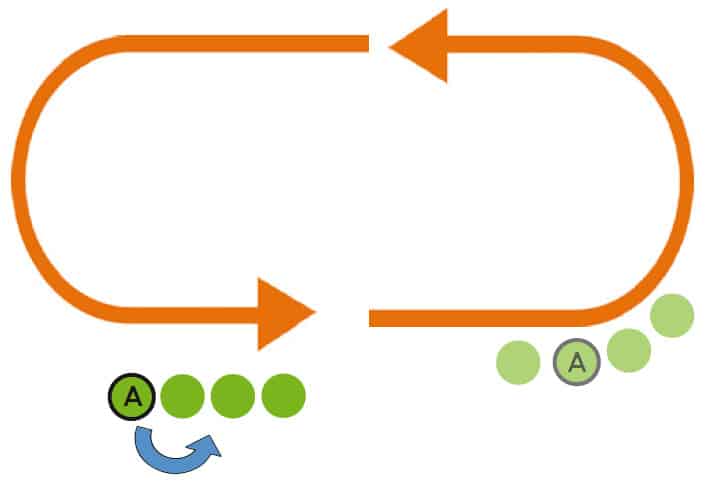 The aim is to pass a skater on the outside during the straight line. You should do your best to have completed the pass before entering the corner!
The aim is to pass a skater on the outside during the straight line. You should do your best to have completed the pass before entering the corner!
Make groups of 4 skaters, the last skater of the group has to pass the skater in front of him, on the outside and before the next corner.
Our tips
- Build your momentum while exiting the corner in speeding up
- One outside pass per lap only, since it is longer to complete than the inside pass
- Don’t try to keep contact here
- Build your corner in order to exit out of it with two very quick cross-overs
- That pass can only be done in wide places
Skater A passes the skater in front with a momentum built beforehand. >>
3) Line Pass
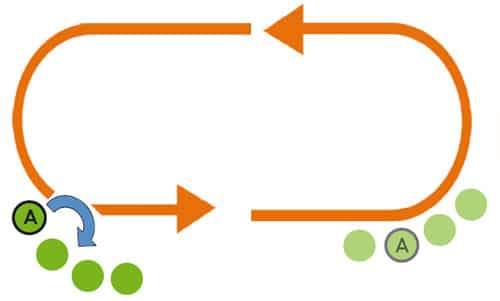 The aim is to pass a skater on the inside while exiting the corner.
The aim is to pass a skater on the inside while exiting the corner.
Make groups of 4 skaters, the last skater of the group has to pass the skater in front of him on the inside, as soon as he exits the corner.
The idea is to ‘slip’ in front of the skater without any effort.
Our tips
- Build your momentum in the corner especially with an efficient speed up
- Take advantage of the deviation of the pack from the inside line due to the speed
- Stick to the inside line to pass the skater that deviates from it
- Build your corner in order to exit out of it with two very quick cross-overs
- Complete the pass as fast as possible
Skater A passes the skater in front, while exiting the corner on the inside, with a momentum built beforehand. >>
4) Corner Pass
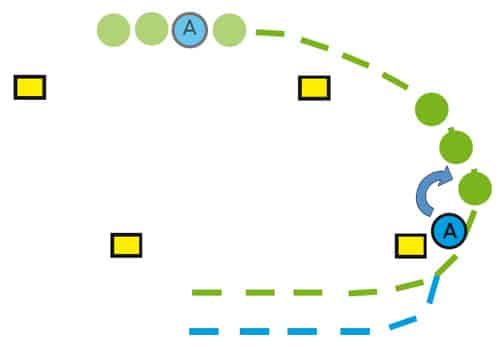 The aim is to pass a skater on the inside, in the corner.
The aim is to pass a skater on the inside, in the corner.
Make groups of 4 skaters, the last skater of the group has to pass the skater in front of him on the inside, in-between the two cones that mark the limits of the corner.
Our tips
- Build your momentum at the end of the straight line, in curving your corner entry
- Make sure not to curve too much so that you don’t get passed on the inside
- – Repeat the situation until you master that type of pass
- Warning: It is a risky pass! It should only be done if the front skater deviates from his natural trajectory
Skater A passes the skater in front during the corner. Reference can be made to the notion of ‘uncrossing’, which implies that skater A shouldn’t be on the same trajectory as the front skater.
Most of the time, Skater A curves his corner entry and uncrosses in the corner. >>
5) Corner Cut
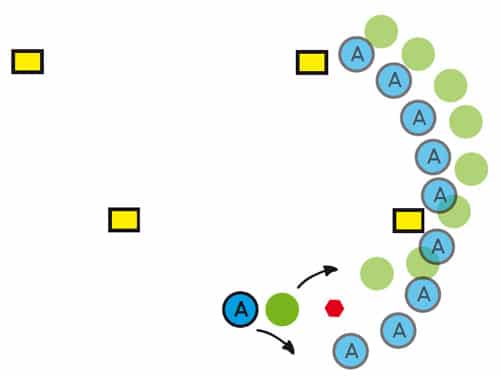 The aim is to create inevitable trajectories that will lead to passing possibilities in a corner.
The aim is to create inevitable trajectories that will lead to passing possibilities in a corner.
Make the skaters pair up. Put a cone at the start of a corner (cf. red hexagon on the diagram).
The first skater (green) takes the inside of the cone, the second skater (blue) takes the outside.
The green skater is going to widen his trajectory since he kept the inside line, which is going to create passing opportunities for skater blue (A), who curved his corner entry in taking the outside of the red cone.
Our tips
- Build your momentum in accelerating out of the corner
- One corner cut per lap only, since it is longer to complete than the corner pass
- Don’t try to keep contact here
- The 2 skaters should be close together before entering the corner
- Make sure not to curve too much not to get outdistanced
- Repeat the situation until you master that type of pass
- Possibilities of working on that situation with more than 2 skaters (3, 4…)
Variations
With 3 skaters:
- 1 and 3 take the inside line, 2 takes the outside
- 1 and 2 take the inside line, 3 takes the outside
With 4 skaters:
- 1 and 3 take the inside line, 2 and 4 take the outside
- 1 and 2 take the inside line, 3 takes the outside, 4 chooses his side…
The + of SILA Sport
- No cones? You can easily replace them with sneakers for example.
- Insist on the pass timing, it is the most important. Passes should be fast, short and completed at once.
- The theme of this card is a practice theme. We would advise you to do several series of 5 to 10 minutes, focusing on one type of pass per series.
- At first, those drills can be executed at slow speed in order to assimilate the different techniques. Then it is crucial to repeat them at race speed to be specific to the discipline.
Find new additional cards on Silasport.com on the theme of skating technique. Get two bonus drills in downloading the card from Silasport.com. (French)
Useful links
Section: Learning Speed Skating on OLS
Download the presentation card of SILA Coaching concept
Download this learning card in .pdf (French)
See the SILA card on reaction time
Photos : NSC, droits réservés
